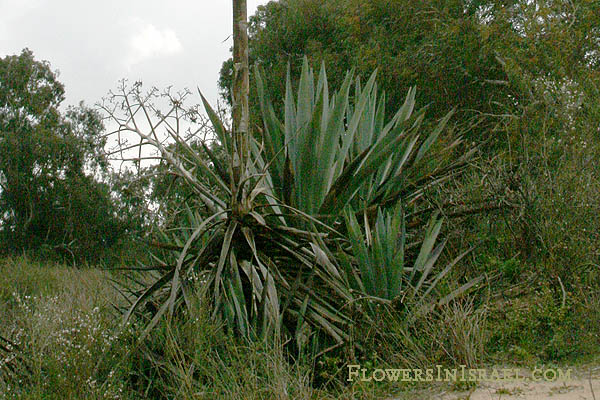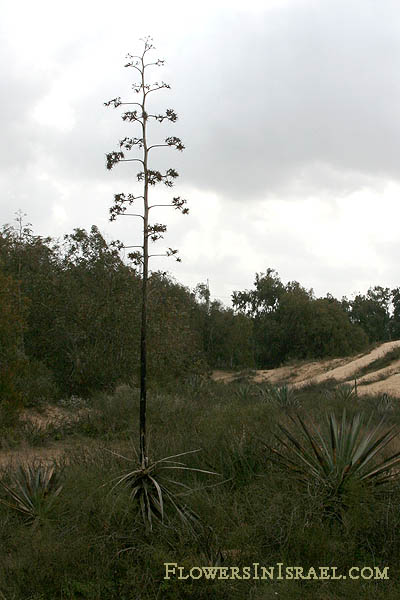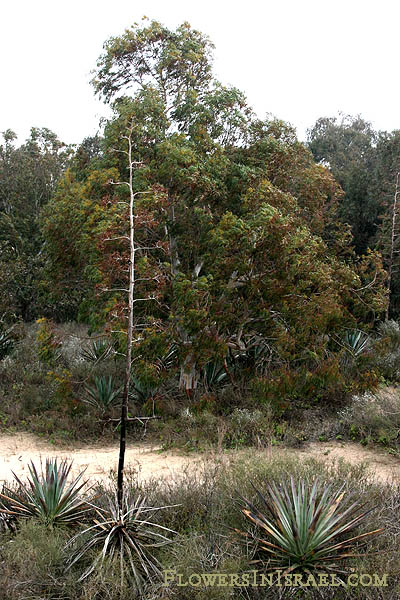Century plant, American agave, American-aloe,
Hebrew: אגבה אמריקנית, Arabic: أغاف أمريكي
| Scientific name: | Agave americana L. | |
| Synonym name: | Agave ramosa Moench | |
| Common name: | Century plant, American agave, American-aloe | |
| Hebrew name: | אגבה אמריקנית | |
| Arabic name: | أغاف أمريكي | |
| Family: | Agavaceae |

|
| Life form: | Perennial, rhizomatous | |
| Leaves: | Basal rosette, succulent, gray-blue up to 2m. long and 25 cm wide; sharp spines on the margins and tips. The margin spines are recurved like fishhooks and the tip spines can be more than 2,5 cm long. | |
| Flowers: | spike with an cyme of big cream flowers up to 8 m in height; it does take about 10 years in warm regions and as much as 60 years in colder climates. It dies after blooming (monocarpic) | |
| Flowering Period: | Early Summer to Late Summer | |
| Habitat: | not below 10 degreees Celsius | |
| Distribution: | Sand | |
| Chorotype: | Mexico | |
| Summer shedding: | Perennating |

Derivation of the botanical name: Agave, Greek agauos, agavos, admirable, noble, splendid, in allusion to the splendid appearance of the plants in flower. In Greek mythology Agave was a daughter of Cadmus and Harmonia. americana, from America, North or South. ramosa, ramosus, with many branches; branched. The Hebrew word: אגבה אמריקנית , a tranlation from the scientific name Agave.
*Preferred Citation: Biological Invasions in Europe and the Mediterranean Basin (Monographiae Biologicae) by F. di Castri, A.J. Hansen, and M Debussche (Jul 31, 1990) Agave has large rosette of sword-shaped fleshy leaves, each ending in a sharp point and with a sharp margin. A leaf can reach the lengths of a person. During flowering a tall stem or "mast" grows from the center of the leaf rosette and bears a large number of shortly tubular flowers. After development of fruit, the original plant dies, the flower shoot is cut out and the sap collected and subsequently fermented. By distillation, a spirit called mezcal is prepared; one of the best-known forms of mezcal is tequila. Agave americana is the source of pita fiber and is used to be turned into ropes. The sisal plant has a 7-10 year life-span and typically produces 200-250 commercially usable leaves. Each leaf contains an average of around 1000 fibres. The first commercial plantings in Brazil were made in the late 1930s and the first sisal fibre exports from there were made in 1948. In the 50th in the Negev about 4,000 dunam of Agave plants were planted (agricultural industrial suitable solution to the grounds of the Negev). The target of the governmental initiative was to develop sources of employment to the towns of the development that were set up in the same time, Dimona, Ofakim and Netivot. Jewish Agency’s Settlements and Negev departments organized to meet the production of industrial crops in order to stimulate agricultural related industries and the export market. A few years later a contract was signed for a factory of fibers 'ifco' with three Jews from Mexico, ( 20% from the shares – in the ownership JNF), machinery was bought from Germany and 19.3.1961 the factory began to work, adjacent to the Gilat junction. Gilat is situated in Israel's northern Negev (31°20' N, 34°40' E, elevation 150 m above mean sea level) near Ofakim. After two years, as a result of conflicts, decomposed the corporate ownership and the factory in entirety, on 102 employees was handed over to the JNF – the only industry she ever operated. But - "The business did not work": The factory finally closed on 29.3.1966. 
|